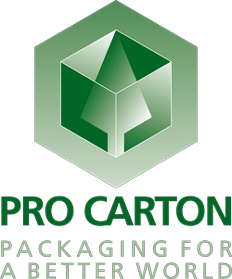What do international trend agencies say about the year 2022? Pro Carton has compiled the most important forecasts for the retail trade, brands and packaging. The merging of real and digital continues to progress, and this will have a significant impact on packaging. It will no longer only have to excel on the shelf and will also have to take on much more responsibility online.
Many of the trends addressed here are not new in terms of approach, but this year they will be reaching a new level of quality. “People are looking for solutions that lead to a positive future. We have one: Cartonboard,” says Winfried Mühling, General Manager of Pro Carton.
Digitalisation: New dimensions
NEW in 2022: Digitalisation is becoming much more radical and is really affecting all areas. Real things are being replicated on the Internet, and in addition there’s augmented reality and gamification. Packaging should provide corresponding offers.
Digitalisation will take another big step forward in 2022. Not only are Internet retailers setting up real shops, real shops are also being digitally recreated. In January, Samsung opened a virtual replica of its flagship store in New York City. Back in July 2021, luxury brand Fendi opened a 360-degree digital flagship based on its 57th Street shop in New York City, offering visitors virtual tours. Hermès has opened digital flagships in Singapore, the United Arab Emirates and Thailand.
This is where the metaverse comes into play. Codes on packaging must lead to comprehensive information and user experiences:
- Augmented reality will open up new spaces. Not only will the advertising world spend most of its time here; information, entertainment, enjoyment and stimulation will form an ever greater part of the product and the packaging itself.
- As people increasingly converse via WeChat, WhatsApp and Line, brands are also jumping onto these chat platforms to build more personal relationships with individual consumer groups. Personalised packaging could constitute one of the many small rewards for joining in.
- Gaming and consumption are merging seamlessly: “The growth of gaming as a marketing platform is unique,” says Grant Paterson, head of gaming and e-sports at Wunderman Thompson. “We’re talking about gaming as the core of a new consumer paradigm.”
wundermanthompson.com/expertise/intelligence
Consumers: Regaining lost trust
NEW in 2022: Greenwashing has taken a heavy toll on consumer trust. To regain lost trust, very concrete, easy-to-follow communication steps are needed. Packaging must have a trust-building design.
While 60 per cent of consumers in Euromonitor International’s Voice of the Consumer Lifestyles Survey 2021 said they feel they can make a difference in the world through their choices and actions, only slightly more than 10 per cent of companies successfully communicated sustainability information, according to the Voice of the Industry Sustainability Survey 2021 from the same institute.
“For too long, the advertising industry has evaded scrutiny about its role in the climate crisis,” says Robbie Gillett of Adfree Cities. “Whether it’s using the best creative to promote carbon-intensive products, misleading greenwash for big oil, or filling our public spaces with energy-intensive ad screens, the juggernaut of polluting PR must end.”
Brands will have to work harder to provide consumers with reliable information and establish authenticity. Clear, well-structured packaging can help brands do this.
Brands: Almost a question of faith
NEW in 2022: For the first time, the quality of products is not as important as whether they suit your lifestyle. The decision for a product becomes a question of faith. Packaging must adopt the symbols of the target group and respond to their needs. The logical consequence; the same product will not always have the same packaging.
77 per cent of consumers worldwide expect support from brands in times of crisis. Sustainability is not enough; people want to be actively addressed. Branding in 2022 must target the individual experience rather than focusing on traditional demographic indicators.
New rules of attraction have changed the way products come to market. Whereas it used to be R&D and marketing departments, product success is now often orchestrated by influencers who first build the audience and then develop the appropriate products. The market of belonging and like-minded people is re-dividing the market of products and services.
www.trendwatching.com/22-trends-for-2022
trendbuero.com Trends to Watch 2022
The personalisation megatrend highlights consumers’ increasingly ego-centric expectations, including highly customisable and personalised consumer goods. This includes a visual culture that prioritises self-expression over others online. The composition of our personal “brands” influences everything we do and consume.
Retailing: Only the best of everything
New in 2022: The development of the product range has not kept pace with the needs of customers; there is a great need to catch up in terms of real sustainability and to actively weed out non-sustainable products and packaging. For the first time, digital presence has become at least as important as real presence.
A significant part of the retail sector has gone digital and will remain so. 81 per cent of consumers worldwide now believe that a brand’s digital presence is as important as its in-store presence, according to a July 2021 survey by Wunderman Thompson Data, prompting brands to increase their e-commerce presence and establish virtual flagship stores.
wundermanthompson.com/expertise/intelligence
Commitment to sustainability continues to grow. One in three Germans would pay more for sustainable products. This is the result of a survey by the management consultancy Simon-Kucher & Partners. Younger people in particular are prepared to pay more in return for a clear conscience. Those in Germany who are willing to pay a premium for more sustainable products would accept additional costs of 18 per cent on average.
“The retail sector still has some catching up to do in terms of implementation. There are numerous possibilities for retail companies in particular,” says Andreas Stein, retail expert at the consultancy TCS. “Sustainability is not limited to lower CO2 emissions through energy-efficient building control and vehicles or optimised flow of goods. Consumers and companies themselves want more transparency “, says Stein. Packaging should support consumers much more actively in choosing the right products.
Packaging: Recyclable and compostable
New in 2022: Plastic is the number one enemy, although this is not always justified. Those who use plastic must justify it well. Packaging should leave no trace in nature, even if it is not recycled.
More than half of consumers worldwide consider sustainable packaging before buying a product. According to an analysis by Future Market Insights, sustainability is the most important driver of smart packaging growth.
The perception that plastic packaging is worse for the environment than others is prompting many packaging brands to look for alternatives. Whether they are edible, biodegradable, compostable or simply reusable, waste-reducing materials are the future of food and beverage packaging.
France is leading by example and since January 2022 has banned plastic packaging for almost all fruits and vegetables in order to reduce plastic waste. Spain is expected to follow suit from 2023.
For Winfried Muehling, General Manager of Pro Carton, this is all good news: “In addition to its unrivalled environmental benefits, cartons offer excellent opportunities to protect the product in an environmentally friendly way and to present product information in a consumer-friendly way. Packaging is increasingly influencing brand character, becoming an increasingly defining part of the brand. With packaging made of cartonboard, we are very well positioned to solve our customers’ challenges.”
Sources




